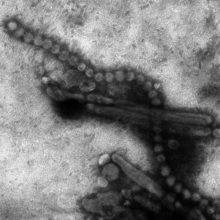Influenza A virus subtype H7N9

Electron micrograph of Influenza A (H7N9).
|
|
| Date | March 31, 2013–present |
|---|---|
| Location |
|
| 316 deaths (through August 2016) | |
| 775 cases (through August 2016) | |
H7N9 is a bird flu strain of the species Influenza virus A (avian influenza virus or bird flu virus). Avian influenza A H7 viruses normally circulate amongst avian populations with some variants known to occasionally infect humans. An H7N9 virus was first reported to have infected humans in March 2013, in China. Cases continued to be reported throughout April and then dropped to only a few cases during the summer months. At the closing of the year, 144 cases had been reported of which 46 had died. It is known that influenza tends to strike during the winter months, and the second wave, which began in October, was fanned by a surge in poultry production timed for Chinese New Year feasts that began at the end of January. January 2014 brought a spike in reports of illness with 96 confirmed reports of disease and 19 deaths. As of April 11, 2014, the outbreak's overall total was 419, including 7 in Hong Kong, and the unofficial number of deaths was 127.
A 5th epidemic of the H7N9 virus began in October 2016 in China. The epidemic is the largest since the first epidemic in 2013 and accounts for about one-third of human cases ever reported. The cumulative total of laboratory-confirmed cases since the first epidemic is 1,223. About 40 percent have died. The CDC estimates that the H7N9 virus has the greatest potential compared with other influenza A viruses to cause a pandemic, although the risk is low because like other type A viruses, it is not easily transmitted between people in its current form.
The World Health Organization (WHO) has identified H7N9 as "...an unusually dangerous virus for humans." Most of the cases resulted in severe respiratory illness, with a mortality rate of roughly 30 percent. Researchers have commented on the unusual prevalence of older males among H7N9-infected patients. While several environmental, behavioral, and biological explanations for this pattern have been proposed, the reason remains unknown.
It has been established that many of the human cases of H7N9 appear to have a link to live bird markets. As of January 2014, there has been no evidence of sustained human-to-human transmission, however a study group headed by one of the world’s leading experts on avian flu reported that several instances of human-to-human infection are suspected. H7N9 virus does not kill poultry, which makes surveillance much more difficult. Chinese scientists announced the development of a vaccine on October 26, 2013, but said that H7N9 had not spread far enough to merit widespread vaccination. Research regarding background and transmission is ongoing.
...
Wikipedia
